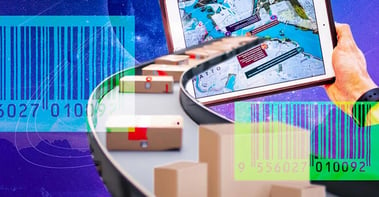The food and drink industry is immense, diverse, and highly consequential. It comprises a vast network of players—from farm to factory to fork. With globalization, these networks and the supply chains by which they deliver value have become increasingly complex.
This complexity has served to help meet rising and varied demands. However, it has also given rise to opaque, unwieldy, and interdependent systems that make it challenging to adapt in the event of disruption. With the onset of the pandemic, these vulnerabilities within many global food & drink supply chains have been exposed. The cascading effects of the past two years have, like in many industries, put additional pressure on food & drink organizations—many of which are already navigating evolving consumer tastes and behaviors and the need to operate more sustainably.
These forces drive innovation and new approaches to value chains in the industry. And rather than thinking narrowly in terms of new products, convenient formats, and customer experience, today’s food & drink industry is increasingly acknowledging the complexity—and myriad opportunities and challenges—that exist in today's global food systems.
In this blog, we’ll present some of the forces shaping the future of the food and drink industry, along with key trends, game-changing technologies, and practical industry applications, highlighting how organizations are finding and leveraging innovative opportunities.
Forces shaping the future of the food & drink industry
1. Global food security
Despite global commitments to achieve zero hunger (SDG 2), more than 30% of the world’s population now faces moderate or severe food insecurity. This figure has risen gradually in the last several years due to climate change, economic downturns, and conflict. The pandemic further exacerbated the issue of food insecurity, exposing weaknesses in food systems and supply chains. Unable to keep pace with growing populations and food demands, existing food systems must undergo transformation. This will require new technologies, corporate governance, and diplomacy to ensure equitable and affordable access to healthy, sustainable diets.
Meeting rising demands and achieving food security for all will require transformation of these systems. This starts with sustainable farm management and land use. Precision Agriculture will help optimize production practices and improve yields by employing drones, IoT, automation, and predictive analytics. Integrating other Future Farming solutions like regenerative agriculture, hydroculture, pasture and crop rotation, and advanced seed coatings will also be essential to systems-level responses.
|
2. The wellness movement
The idea of food as medicine has grown alongside greater awareness and adoption of integrative and holistic approaches to health. The global market for healthier, less processed food & drink will continue to grow as more consumers take control over their health. Meanwhile, the pandemic triggered a rise in demand for products and supplements labeled with “immune support.” There is persistent interest in herbal, CBD, and other functional, natural ingredients that tout therapeutic, cognitive, or anti-aging benefits. However, these so-called nutraceuticals are largely unregulated in many countries, and consumers are increasingly scrutinizing products and seeking Evidence-Based Value.
The pursuit of Pure Goodness—emphasizing minimal additives and preservatives—and the demand for safe and superior quality food will drive further development of Antimicrobial Packaging technology. This “active packaging” reduces the need for added chemical preservatives and maintains the nutritional profile of food products, including the macronutrient, vitamin, and mineral content.
|
3. Planetary health
A new definition of healthy eating is emerging to encompass more than just nourishment. The impact of the food & drink industry on planetary health has come into stark focus. As a result, more consumers are adopting climate-friendly diets that incorporate low-carbon, local, and seasonal foods. There is a growing demand for minimizing food waste and supply chain transparency to validate claims of sustainable, ethical production. These shifts require examination and optimization of the entire value chain—from precision and regenerative agricultural practices to reducing food and packaging waste.
Biomanufacturing and 3D Printing are promising alternative production methods for a more sustainable food & drink industry. As consumer preferences move towards Sustainable Nourishment, the market for meat alternatives—e.g., plant- and insect-based proteins and "lab-grown" meat—grows. However, continued investment into improving and scaling these technologies is needed to reduce price and enhance palatability for consumers.
At the same time, many consumers are inundated with (sometimes conflicting) information on environmentally and socially responsible choices. This has led to the rise of Easy Ethics and brands empowering their customers through accurate information, ethical options, supply chain visibility, and accessible channels for offering input on key issues. An example of Easy Ethics is carbon labeling on food & drink items—in line with the trend Carbon Economy.
|
4. E-commerce
Much like retail, the food & drink industry experienced massive disruption due to the pandemic. Restaurants, supermarkets, and food & drink manufacturers rushed to meet their customers online with e-commerce solutions and on-demand (contactless) delivery. Lockdown periods accelerated the rollout and adoption of these solutions. While some habits are likely to revert to pre-pandemic “normalcy,” the online presence of the food & drink industry and demand for direct-to-consumer services will have permanence. This will require infusing technology into existing distribution and delivery models to streamline operations and elevate the customer experience.
The pandemic has made Rebuilding Retail a priority for many brick-and-mortar outlets in the industry. Businesses must consider new distribution and retail strategies that address the rising dominance of e-commerce and direct-to-consumer services. Even as COVID-19 restrictions ease, Value Drive Delivery of food & drink is expected to thrive and expand into less densely populated areas, made possible by technologies like Unmanned Deliveries, dynamic routing, real-time tracking, and predictive analytics.
|
5. Global flavors
Interest in different food cultures and cuisine continues to rise. Consumers are seeking the novelty of new flavors and the health benefits of traditional ingredients like herbs, spices, fruits, teas, etc. Food & drink companies are competing to identify the next promising local or even hyperlocal flavor to introduce in new markets. Making these flavors mainstream and engaging consumers, in some cases, calls for new formats, creative combinations, and authentic storytelling around the product. However, global supply chain disruptions and shifting climate conditions threaten not only the availability of indigenous crops but their very existence.
With the ongoing debate around cultural appropriation, brands have a fine line to walk when incorporating and marketing traditional ingredients and products. Empathetic Brands with a clear set of guiding values will exhibit Local Appreciation. This means engaging with, uplifting, and recompensing the communities or organizations that are custodians of the traditional knowledge related to the food or drink.
Consumers are also increasingly interested in Tracing Origin to ensure provenance claims on food & drink products. Blockchain Track-and-Trace can enable uninterrupted, unimpeachable origin tracing, protecting the interests of all players and reinforcing a trustworthy, authentic supply chain story.
|
6. Supply chain resilience
Disruptions to the food & drink industry have persisted since the start of the pandemic. Labor shortages and transportation bottlenecks have exposed vulnerabilities, especially in global supply chains. The situation is made worse by increasingly severe and frequent weather events. As a result of these factors, the cost of doing business and, in turn, food prices continue to rise. To break this cycle of disruption and inflation, food & drink producers are seeking ways to improve the resilience and agility of their supply chains—from shifting to Localized Production and reducing wastage to digitalizing and automating workflows.
Resilient supply chains are inherently Green and Lean—optimized to be both more efficient and sustainable. Intelligent emergent technologies like IoT, AI/ML platforms, robotic process automation, and digital twins enhance green supply chain management and are essential to Automating a Greener World.
|
Finding innovation opportunities in the food & drink industry
Applying an industry lens to the process of environmental scanning helps your foresight teams direct their focus and resources more optimally. By gaining an understanding of the technological developments and trends that may present future opportunities in your industry, you can equip yourself with the foresight intelligence needed to take decisive, strategic action and, ultimately, gain a competitive advantage.
Get started by exploring the ITONICS Technology Radar and Trend Radar for the food & drink industry. These analyst-curated radars display the drivers of change that are most relevant and impactful for the industry.
If you want to evaluate further the impact and relevance of these trends and technologies for your business, kick-start your innovation journey on the ITONICS Innovation OS today.



/Assets%20and%20Heros/nav-thumbnail-Gartner.webp?width=150&name=nav-thumbnail-Gartner.webp)







